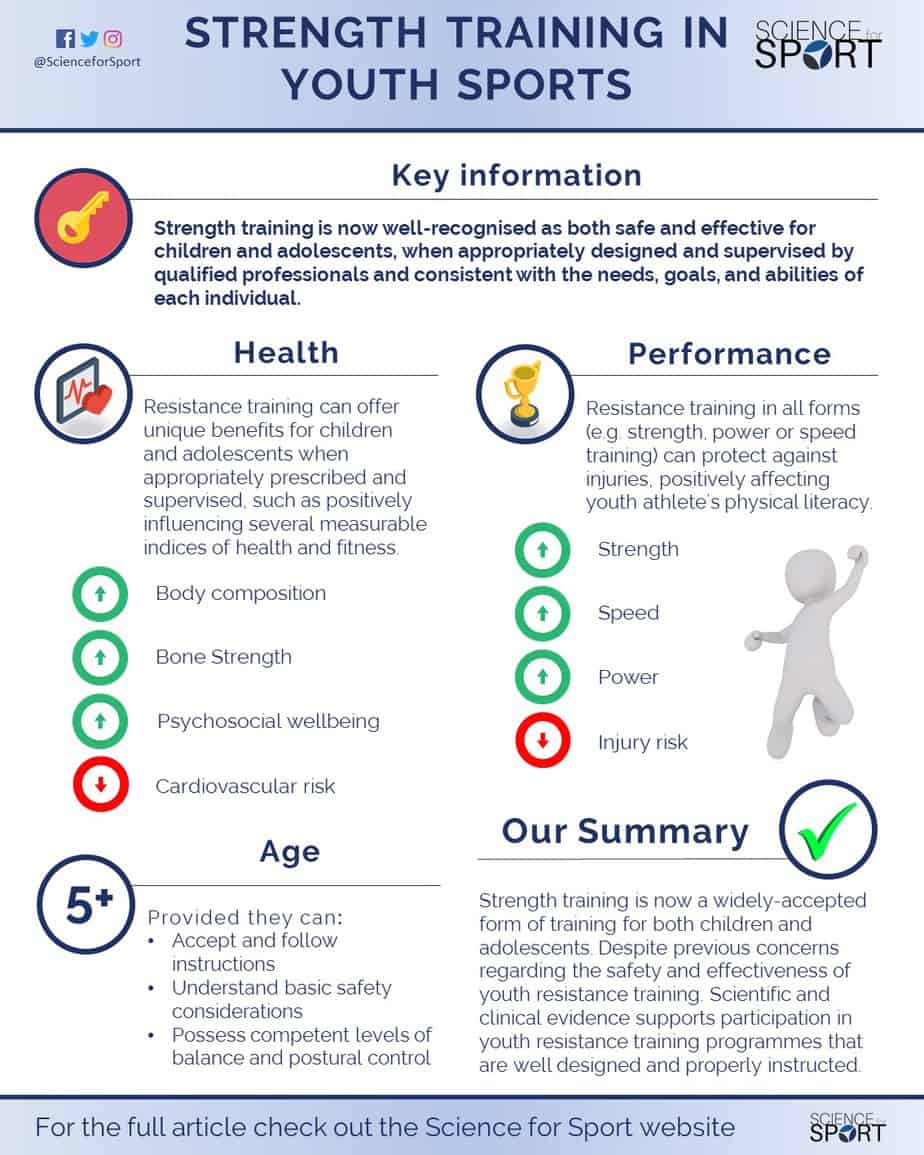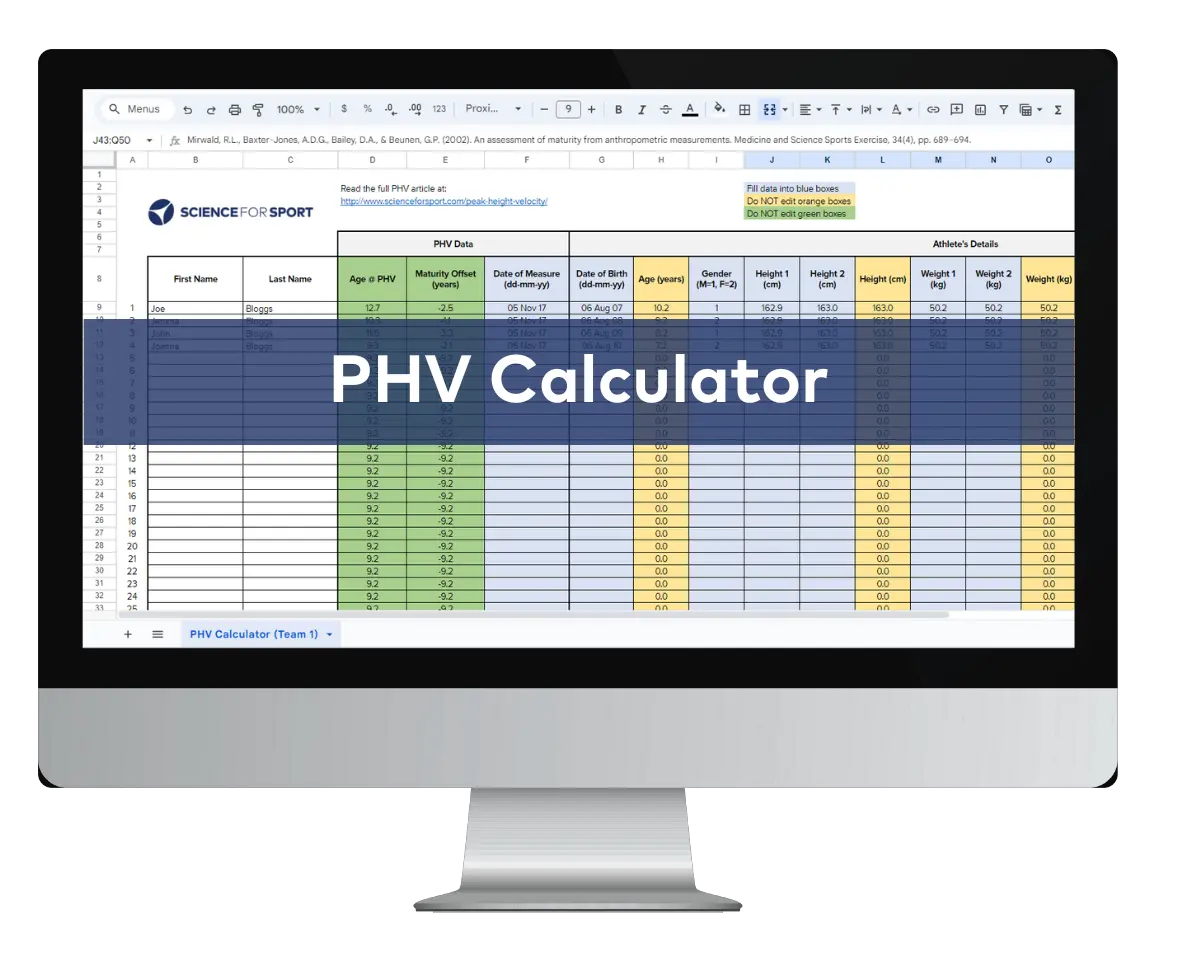Contents of Article
- Summary
- Is strength training appropriate for young athletes?
- Is strength training important for sports?
- Is strength training important for health?
- When should children begin strength training?
- Is future research needed with youth strength training?
- Conclusion
- References
- About the Author
Summary
Youth strength training is a topic of interest for many researchers, clinicians, practitioners and coaches. When to start, how much is enough or too much, and what to prescribe is constantly debated and put under scrutiny.
However, at present, a compelling body of scientific evidence supports participation in appropriately designed youth resistance training programmes that are supervised and instructed by qualified professionals. Moreover, the benefits of strength training starting at younger ages can eventually have long-term implications for an individual’s healthy lifestyle and future sports participation.

Is strength training appropriate for young athletes?
The participation of children and adolescents in various forms of resistance training has been an area of both interest and controversy for the past decades (1, 2). Researchers, clinicians and coaches have all provided their expert input, and over the past few years several prestigious organisations and national associations have developed policy documents or position stands to summarise key findings in the area and provide guidance for coaches, parents and teachers (1, 3, 4).
It is commonly stated that “children are not miniature adults”, and because of their immature physiological and psychological state, they should be prescribed appropriate training programmes according to their technical ability and stage of development (5). As growth and maturation develop in a non-linear way through childhood and adolescence, this has a great impact on the adequate training prescription required by each individual (5, 6).
Recent research has indicated that resistance training can elicit significant performance improvements in muscular strength, muscular endurance, power production, change of direction speed and agility, balance and stability, coordination and speed of movement in youth athletes (2, 3). It also has positive effects on health (e.g. decreased cardiovascular disease risk), in addition to improving psychological well-being (3, 4), as well as helping to reduce both the severity and incidence of injuries (7).
In accordance, strength training is now well-recognised as both safe and effective for children and adolescents when appropriately designed and supervised by qualified professionals and consistent with the needs, goals and abilities of each individual (2, 8, 9, 10). There is also a compelling body of scientific evidence that supports regular participation in youth resistance training to reinforce positive health and fitness adaptations and sports performance enhancement (2).
Older myths and misinformation, regarding the potential negative effects of resistance training for children, have been refuted. Thus, coaches, fitness professionals, and young athletes can now focus on the optimal training regimens to enhance muscular fitness and athletic performance (3).
Clarity of some common terms
Prepubescent – before the age at which a person begins puberty (approximately 11.5-13.5 years).
Adolescent – from the onset of puberty to the end of pubertal growth (approximately 18 years).
Children – from 2 years old to the onset of puberty.
Youth – the period between childhood and adulthood.
Is strength training important for sports?
The improvement of athletic performance in youth athletes is a complex task, and achieving high levels of athleticism requires a robust long-term plan. Sports participation alone, in many cases, does not offer sufficient stimulus to achieve this. Resistance training in all forms (e.g. strength, power or speed training) can help to attenuate these issues by protecting against injuries and positively affecting youth athletes’ physical literacy, thus, diminishing the impact of low physical activity and early sport specialisation among youths (7).
Stronger young athletes will be better prepared to learn complex movements, master sport tactics, and sustain the demands of training and competition (11). Thus, resistance training prescription should be based on an appropriate progression according to training age, motor skill competency, technical proficiency and existing strength levels. Another factor to consider is the biological age and psychosocial maturity level of the child or adolescent (1, 6).
A high level of muscular strength contributes to enhancing performance ability in young athletes. Moreover, it is also important to build a good base of fundamental movements during childhood and adolescence, as this will help the youths develop more efficient motor skills whilst simultaneously reducing their risk of injury due to improved body control and/or technique (11).
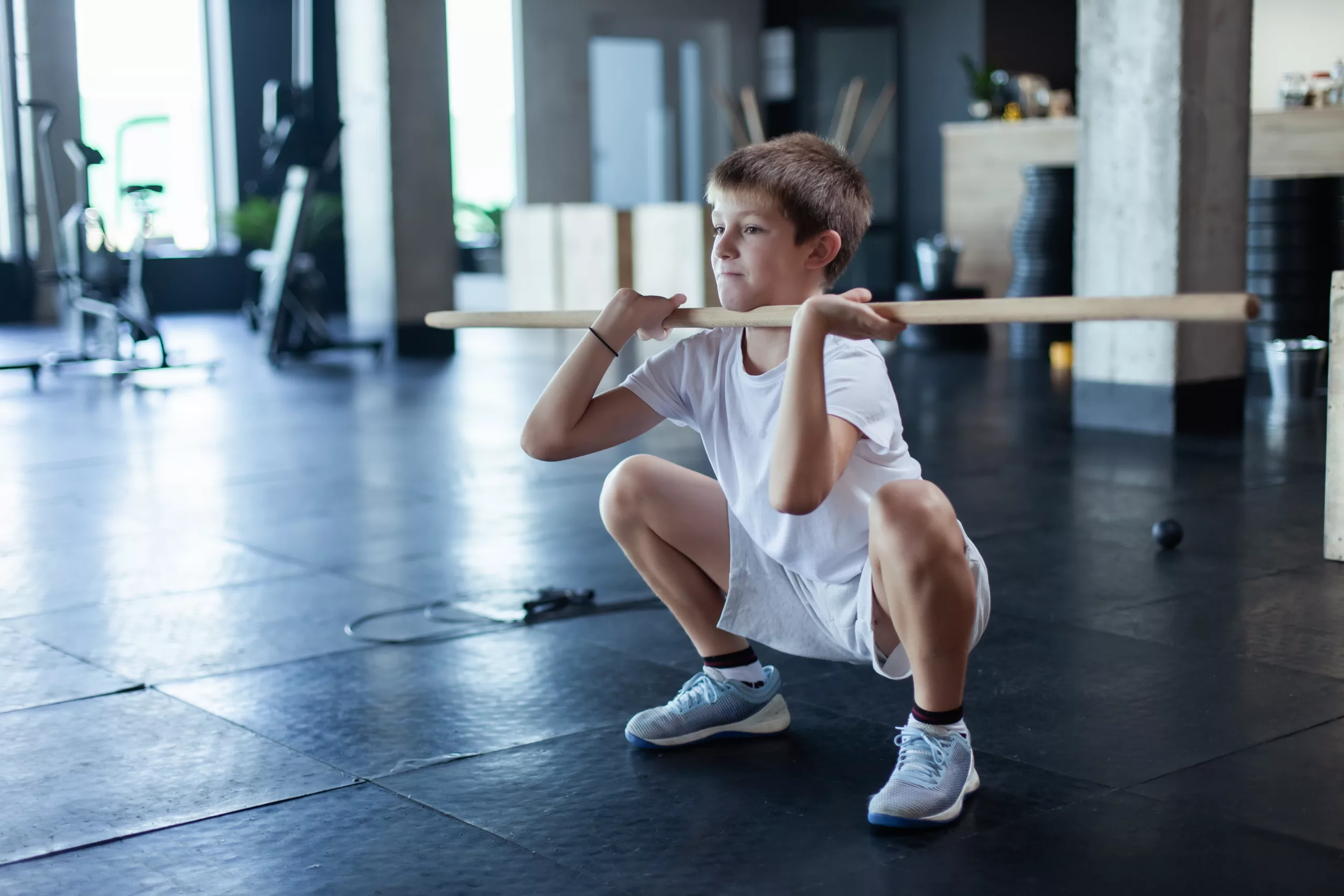
Strength
The ability to produce high levels of force is important for sports performance at all levels (9). Good parameters of maximal muscular strength influence performance due to increases in muscular power and muscular endurance (12).
Resistance training has been found to be an effective method to promote muscular strength and jump performance in youth athletes (9). Moreover, it has been shown muscular strength has a direct impact on running speed, muscular power, change of direction speed, plyometric ability, and endurance (13). In accordance with this, it seems that muscular strength is critical for the efficient development of fundamental movement skills (FMS) (13).
The development of muscle strength depends on multiple factors, such as muscular, neural, mechanical, psychological and hormonal (13, 14). Moreover, strength develops in a non-linear way throughout childhood and adolescence. Nevertheless, strength tends to increase similarly both in girls and boys until the age of 14, where a plateau begins in girls and a spurt is evident in boys (8).
It is important to acknowledge the fact that growth and maturation will affect strength gains both before, during and after puberty (14). In this sense, it has been found that relative strength gains in prepubescents are equal, or greater, to those shown by adolescents. In general, adolescent absolute strength gains appear to be greater than prepubescent gains, but less than adult gains (11).
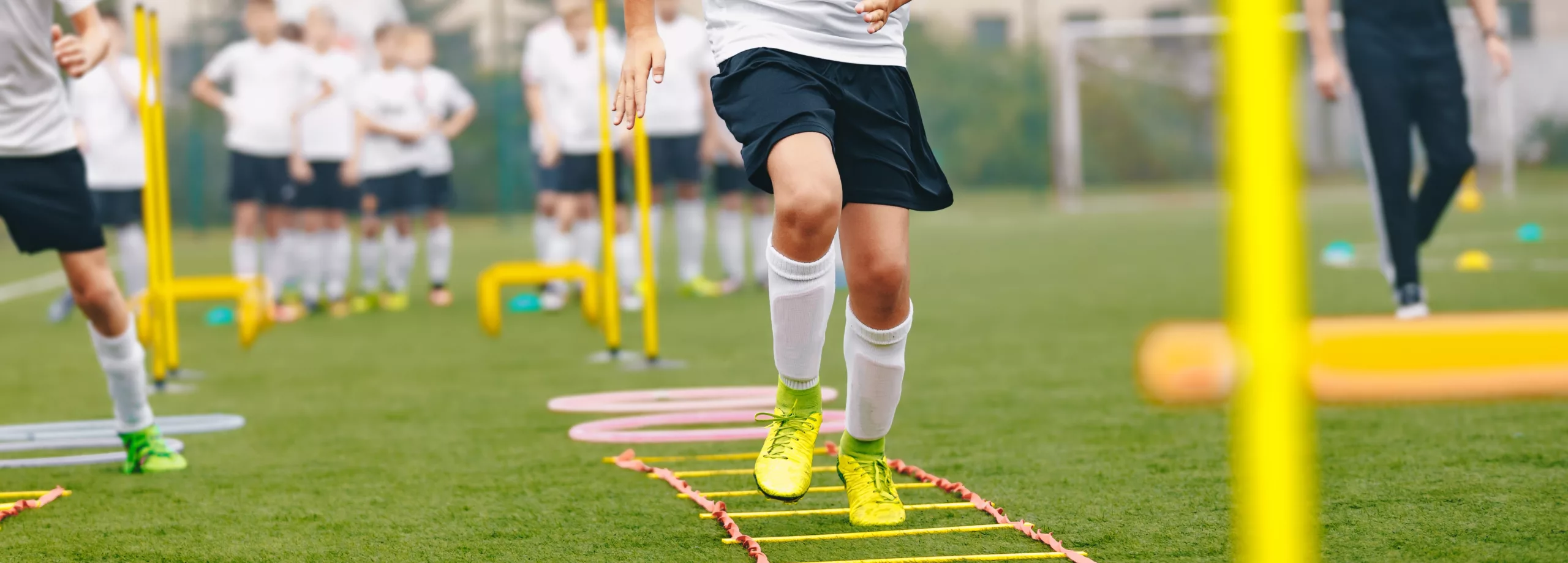
Speed
The development of speed throughout childhood will be influenced by multiple changes in the muscle, such as growth in cross-sectional area and length, biological and metabolic changes, neuromuscular development, and changes in biomechanical factors and coordination (8). As well as with other physical traits, speed development occurs in a non-linear way throughout childhood (16).
In terms of speed development throughout childhood and adolescence, it has been shown that weight gains during puberty can negatively affect a young athlete’s speed. Strength training can, therefore, be an effective way to overcome the negative influence of this increase in mass by enhancing force production. Simultaneously, it would also positively impact favourable changes in body composition, thus maximising relative maximal force (i.e. the amount of force an athlete can apply in comparison to their body weight) (16).
Finally, recent findings have shown that the variance in sprint performance in adolescent boys may be the result of varying degrees of strength and power. This implies the importance of an early introduction to resistance training for boys wishing to enhance their maximal speed (16).
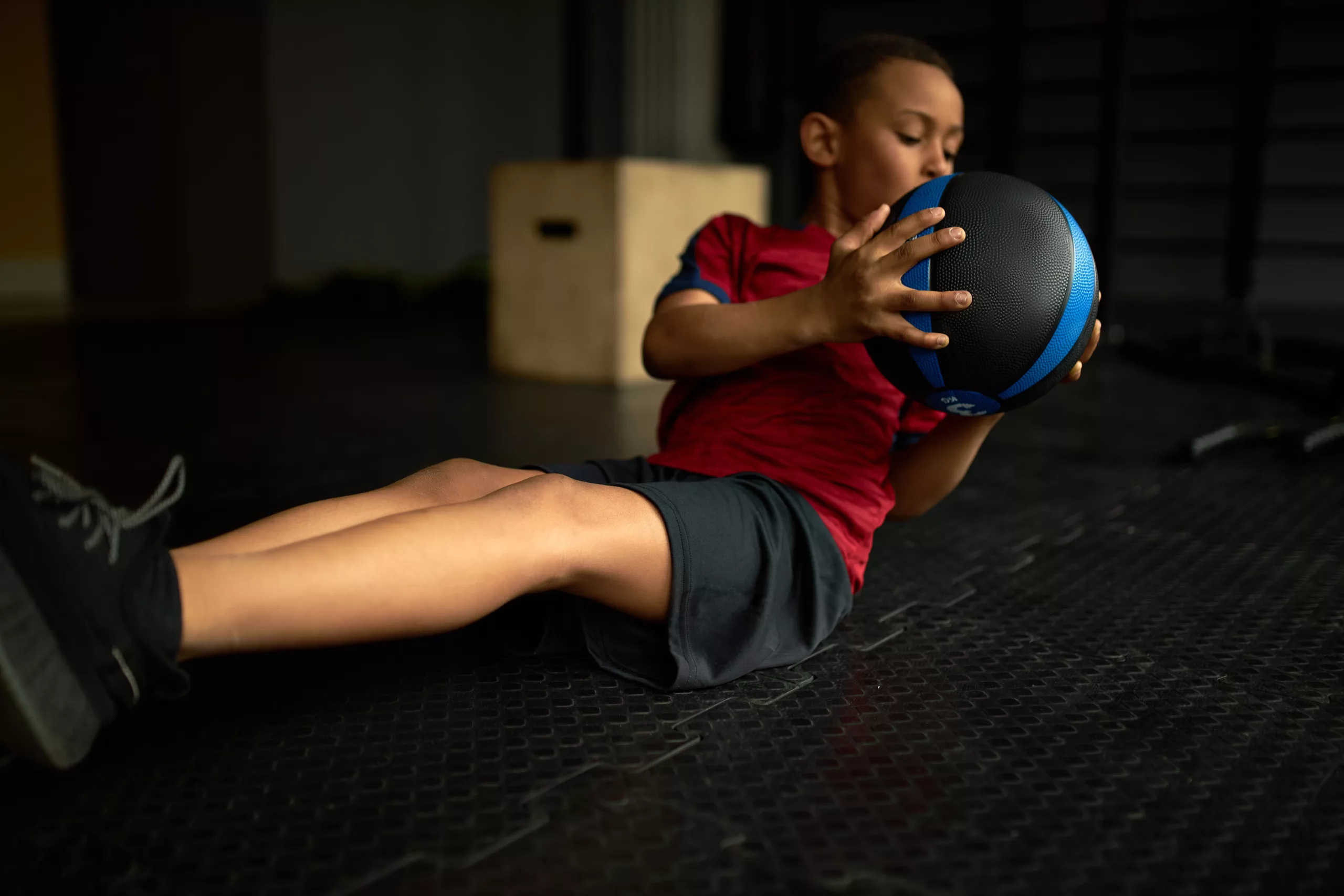
Power
Increases in muscular power occur around the time of peak height velocity among youngsters. Moreover, the time when peak muscular powers become noticeable tends to coincide with peak weight velocity. This phenomenon suggests that increases in both muscle mass and motor unit activation are closely linked to the development of muscular power (16).
Evidence in the literature has shown that plyometric training (17) and strength training (3, 18) both have a positive impact on enhancing muscular power in young athletes; even when used in isolation (19) and in combination (9). As such, strength training can have a significant impact on the power production abilities of young athletes, and considering power is a vital aspect of many sports (20), there is plenty of justification for the inclusion of strength training within the young development programme.
Injury Reduction
Participation in sport involves some inherent risk of injury, and although the total elimination of sport-related and physical activity-related injuries is an unrealistic goal, it appears that an all-round programme which focuses on increasing muscle strength, enhancing movement mechanics and improving functional abilities may be the most effective strategy for reducing sports-related injuries in young athletes (2, 6, 10). The strengthening of muscles and connective tissues through strength training makes young athletes capable of sustaining higher external forces, which therefore makes them less susceptible to soft-tissue injury (6, 21).
Additionally, the effectiveness of these injury prevention programmes – a good example of which is the FIFA 11+ – is greater if implemented in younger age groups prior to the commencement of neuromuscular deficits and biomechanical alterations seen during growth spurts (2). In female athletes, for example, early engagement in neuromuscular training is likely to result in a reduced risk of anterior cruciate ligament injury later in life (6, 21). Furthermore, specific resistance training exercises can help to prevent the development of bone injuries (e.g. Sever’s disease) (22).
Moreover, as growth and maturation are periods of rapid development, young athletes are at a greater risk of sustaining injuries, whether they participate or not in competitive sports or non-competitive recreational physical activity (6). In many cases, it is also well-acknowledged that strength training sessions carry a lower risk of injury in comparison to the sport itself (4). This simply means that children are more likely to get injured playing their respective sport than they are during strength training (providing appropriate supervision is in place).
Is strength training important for health?
There are many health benefits associated with regular physical activity in children and adolescents. Recent findings indicate that resistance training can offer unique benefits for children and adolescents when appropriately prescribed and supervised, such as positively influencing several measurable indices of health and fitness. For example (2, 10):
- Body composition
- Cardiovascular risk profile
- Reduce body fat
- Facilitate weight control
- Improve insulin sensitivity
- Strengthen bone
- Enhancing psychosocial wellbeing
A strength training programme also seems to be particularly beneficial for sedentary youth who are often unwilling and unable to perform prolonged periods of aerobic exercise, such as overweight or obese children and adolescents. Participation in a formalised training programme that is inclusive of resistance training can provide an opportunity to improve their muscle strength, enhance motor coordination and gain confidence in their perceived abilities to be physically active (2, 23).
Moreover, participation in youth programmes that enhance muscular strength and fundamental movement skill performance early in life appears to build the foundation for an active lifestyle later in life. Since muscular strength is an essential component of motor skill performance, developing competence and confidence to perform resistance exercise during the growing years may have important long-term implications for health, fitness, and well-being (2).
Bone Development
Despite previous concerns developed from unsubstantiated evidence in the 70s and 80s (10), resistance training seems to be an effective strategy for increasing bone health during the growing years (10, 24, 25). As well as optimising skeletal health during childhood (25, 26), this is also important for reducing the likelihood of fractures later in life (28). Participation in regular strength training has been shown to improve both bone mineral density (24, 29) and geometry (24, 25).
Several findings have pointed out a positive link between physical activity and bone health across the age spectrum (30). Moreover, resistance training has no detrimental effect on linear growth in children and adolescents (4), although, it has been suggested that mechanical loading of bone has a threshold that must be met to have a positive effect on factors related to bone health (4, 21).
Traditional fears and misinformed concerns that resistance training would injure the growth plates of youths are not supported by robust scientific reports or clinical observations (2). Instead, the mechanical stress placed on the developing growth plates from resistance exercise appears to be very beneficial for bone formation and growth (2, 31). Furthermore, these benefits in bone mass in children are maintained into adulthood (30).
While numerous factors, including genetics and nutritional status, influence skeletal health, regular participation in sports and fitness programmes can help to optimise bone-mineral accrual and geometry during childhood and adolescence (32, 33, 34).
Cardiovascular Development
There is evidence to indicate that the precursors of cardiovascular diseases have their origin in childhood and adolescence (23, 35, 36). Furthermore, risk factors such as total and high-density lipoprotein cholesterol (HDLc), low-density lipoprotein cholesterol (LDLc), triglycerides, insulin resistance, inflammatory proteins, blood pressure and body fat during childhood have been shown to track into adulthood (35).
Given this, the potential influence of resistance training on body composition has become an important topic of investigation, especially considering that the prevalence of obesity among children and adolescents continues to increase worldwide (11). Furthermore, it seems that a higher level of muscular strength is associated with a healthier cardiovascular profile in children and adolescents (34, 35). However, there is likely to be an upper threshold to this, whereby further increases in strength are not met with an improved cardiovascular profile; not to mention that a correlation does not suggest causality.
Additionally, several recent studies have suggested that resistance training or circuit weight training (i.e. combined resistance and aerobic training) may have favourable health benefits (e.g. body composition) for children and adolescents who are obese or at risk for obesity (11, 36).
Neuromuscular Development
Prepubescent athletes tend to have neuromuscular control deficits (e.g. valgus hip and knee alignment during jump-landing tasks), which in turn, is associated with increased injury risk (21). The neuromuscular control capacities that allow the dissipation of impact forces whilst maintaining proper lower-limb alignment have been identified as key factors in reducing youth athletes’ relative risk of injury (21). In the early period of life, the aim of a neuromuscular training programme should be to improve the movement efficiency and muscular coordination of children (12).
Therefore, it is proposed that resistance training should begin early in life, where the focus should be on enhancing the learning of this new activity and stimulating an ongoing interest in this type of training. Owing to neural plasticity during the growing years, there is an unparalleled opportunity to target strength development during this period in order to set the stage for enhanced athletic skill and health later in life (12).
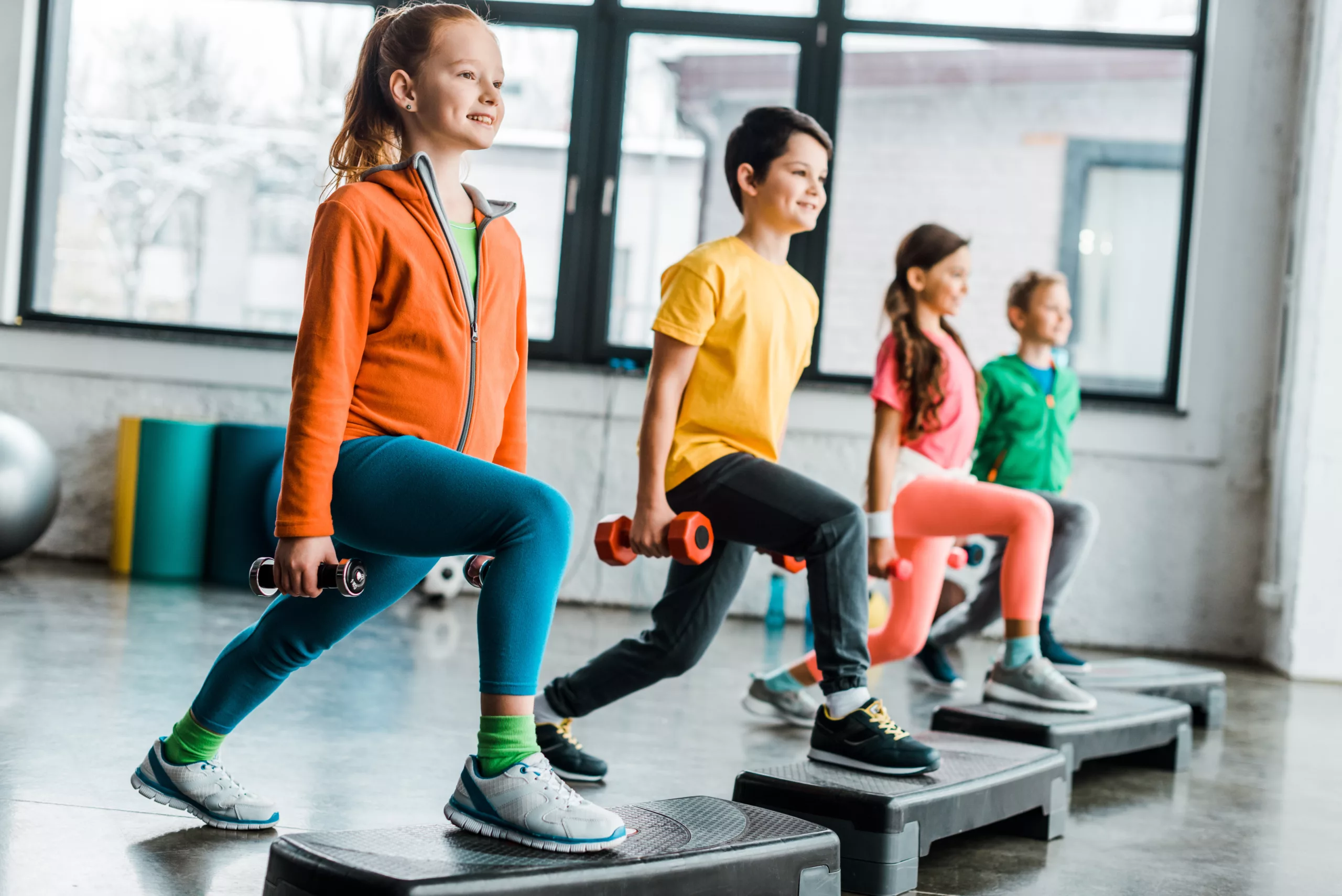
When should children begin strength training?
While chronological age has traditionally been used for initial participation in sports teams (e.g. under-16s), it is clear that differences in growth and maturation (e.g. height, weight, strength) emerge around the age of 6-7 years of age (37). These developmental differences in stature and skill can make programming for youth based on chronological age difficult and also unfair due to biological maturity and the relative age effect (37).
Although there is no minimum age requirement for participation in a youth resistance-training programme, all participants should have the fundamental competence too (1, 2, 10):
- Accept and follow instructions
- Understand basic safety considerations
- Possess competent levels of balance and postural control
Thus, youth strength training could start with children as young as 5–6 years of age, providing they present these fundamental characteristics. Even children that young have been shown to make noticeable improvements in muscular fitness following exposure to basic resistance training exercises using body weight, free weights, machine weights and elastic resistance bands (2).
Another way to view this question is, if children are ready to engage in organised sports, it would also mean they are ready to participate in appropriate progressive strength and conditioning as part of a long-term approach to developing athleticism (6). It is vital to understand that introductory strength and conditioning does not start with heavy back squats, but instead with bodyweight exercises, the use of elastic-resistance bands and any other low-level strength exercises/modalities.
Is future research needed with youth strength training?
Even though it is accepted that youth strength training is a safe and effective method to enhance physical literacy in youth, there are still some areas that need further research to clarify the specific mechanisms that lead to an improvement in both physical capacities and overall health. Owing to the current lack of longitudinal and well-controlled empirical studies and knowing the complex and dynamic progression that occurs during childhood and puberty, some issues of further interest would be:
- To clarify the specific mechanisms for the health-related benefits (e.g. cardiovascular disease risk, bone health) associated with youth resistance training;
- How to optimise long-term training adaptations and exercise adherence in children and adolescents;
- To investigate in which way strength training interacts with growth and maturity and;
- Explore the potential benefits of resistance training on youth with various medical conditions including obesity, diabetes, and physical and/or intellectual disabilities.
Conclusion
Strength training is now a widely accepted form of training for both children and adolescents. Despite previous concerns regarding the safety and effectiveness of youth resistance training, scientific and clinical evidence supports participation in youth resistance training programmes that are well-designed and properly instructed. These programmes have been found to benefit youths in terms of health and fitness.
Moreover, the benefits of strength training starting at younger ages can eventually have long-term implications for an individual’s healthy lifestyle and future sports participation. Finally, it is recognised that all youth should be provided with training programmes according to their individual needs, within a fun and motivational training environment.
- Wilson, G., Bird, S., O’Connor, D. & Jones, J. (2017) Resistance training for children and youth: A position stand from the Australian strength and conditioning association (ASCA) Original Publication 2007, Updated March 2017. https://www.strengthandconditioning.org/images/resources/coach-resources/resistance-training-for-children-and-youth-asca-position-stand.pdf
- Lloyd, R. S., Faigenbaum, A. D., Stone, M. H., Oliver, J. L., Jeffreys, I., Moody, J. A., . . . Myer, G. D. (2014). Position statement on youth resistance training: the 2014 International Consensus. Br J Sports Med, 48(7), 498-505. https://www.ncbi.nlm.nih.gov/pubmed/24055781
- Granacher U, Lesinski M, Büsch D, Muehlbauer T, Prieske O, Puta C, Gollhofer A and Behm DG (2016) Effects of Resistance Training in Youth Athletes on Muscular Fitness and Athletic Performance: A Conceptual Model for Long-Term Athlete Development. Front. Physiol. 7:164. https://www.ncbi.nlm.nih.gov/pubmed/27242538
- Fleck, S. & Kraemer, W. (2014) Designing Resistance Training Programs. Routledge. London.
- Lloyd, R. S., Oliver, J. L., Faigenbaum, A. D., Howard, R., De Ste Croix, M. B., Williams, C. A., . . . Myer, G. D. (2015). Long-term athletic development- part 1: a pathway for all youth. J Strength Cond Res, 29(5), 1439-1450. https://www.ncbi.nlm.nih.gov/pubmed/25486295
- Lloyd RS, Cronin JB, Faigenbaum AD, Haff GG, Howard R, Kraemer WJ, Micheli LJ, Myer GD, Oliver JL. (2016) National Strength and Conditioning Association Position Statement on Long-Term Athletic Development. J Strength Cond Res. 2016 Jun;30(6):1491-509. https://www.nsca.com/education/articles/NSCA_Position_Statement_on_LTAD/
- Zwolski C, Quatman-Yates C, Paterno MV. (2017) Resistance Training in Youth: Laying the Foundation for Injury Prevention and Physical Literacy. Sports Health. 2017 Sep/Oct; 9(5): 436-443. https://www.ncbi.nlm.nih.gov/pubmed/28447880
- Ford, Paul , De Ste Croix, Mark , Lloyd, Rhodri , Meyers, Rob , Moosavi, Marjan , Oliver, Jon , Till, Kevin and Williams, Craig (2011) ‘The Long-Term Athlete Development model: Physiological evidence and application’, Journal of Sports Sciences, 29: 4, 389 — 402. https://www.ncbi.nlm.nih.gov/pubmed/21259156
- Lesinski M, Prieske O, Granacher U. (2016) Effects and dose–response relationships of resistance training on physical performance in youth athletes: a systematic review and meta-analysis. Br J Sports Med 2016; 50: 781–795. https://www.ncbi.nlm.nih.gov/pubmed/26851290
- Faigenbaum, A. & Westcott, W. (2009) Youth Strength Training: program for health, fitness and sport. 2nd Edition. Champaign: Human Kinetics.
- Faigenbaum AD, Kraemer WJ, Blimkie CJ, Jeffreys I, Micheli LJ, Nitka M, Rowland TW (2009) Youth resistance training: updated position statement paper from the national strength and conditioning association. J Strength Cond Res. 2009 Aug;23(5 Suppl):S60-79. https://www.ncbi.nlm.nih.gov/pubmed/19620931
- Faigenbaum, A., Lloyd, R., & Myer, G. (2015) Citius, Altius, Fortius: beneficial effects of resistance training for young athletes. British Journal of Sports Medicine. https://www.ncbi.nlm.nih.gov/pubmed/26089321
- Lloyd, R.S., Faigenbaum, A. D., Myer, G. D., Oliver, J. L., Jeffreys, I., . . . Pierce, K.(2012) UKSCA Position Statement: Youth Resistance Training. UKSCA 2012; vol.26
- Behringer, M., Heede, A., Yue, Z., and Mester, J. 2010. Effects of resistance training in children and adolescents: A meta-analysis. Pediatrics 125: 999-1000. https://www.ncbi.nlm.nih.gov/pubmed/20974785
- Robert W. Meyers; Jon L. Oliver; Michael G. Hughes; Rhodri S. Lloyd; John B. (2017) New Insights Into the Development of Maximal Sprint Speed in Male Youth. Strength and Conditioning Journal. 39(2):2–10. https://www.researchgate.net/publication/315731329_New_Insights_Into_the_Development_of_Maximal_Sprint_Speed_in_Male_Youth
- Lloyd, R.S., Meyers, R., & Oliver, J. (2011) The Natural Development and Trainability of Plyometric Ability During Childhood. Strength and conditioning journal 33(2):23-32 · April 2011.
- de Villarreal ES, Kellis E, Kraemer WJ, Izquierdo M. (2009) Determining variables of plyometric training for improving vertical jump height performance: a meta-analysis. J Strength Cond Res. 2009 Mar;23(2):495-506. https://www.ncbi.nlm.nih.gov/pubmed/19197203
- Sander A, Keiner M, Wirth K, Schmidtbleicher D. (2013) Influence of a 2-year strength training programme on power performance in elite youth soccer players. Eur J Sport Sci. 2013;13(5):445-51. https://www.ncbi.nlm.nih.gov/pubmed/24050460
- Harries, S. K., Lubans, D. R., & Callister, R. (2012). Resistance training to improve power and sports performance in adolescent athletes: a systematic review and meta-analysis. J Sci Med Sport, 15(6), 532-540. https://www.ncbi.nlm.nih.gov/pubmed/22541990
- Docherty, D, Robbins, D, and Hodgson, M. (2004). Complex training revisited: A review of its current status as a viable training approach. Strength Cond J, 27(4), pp.50-55. https://www.researchgate.net/publication/232240805_Complex_Training_Revisited_A_Review_of_its_Current_Status_as_a_Viable_Training_Approach
- Gamble, P. (2008) Approaching Physical Preparation for Youth Team-Sports Players. Strength and conditioning journal · February 2008. https://www.researchgate.net/publication/232239779_Approaching_Physical_Preparation_for_Youth_Team-Sports_Players
- Naaktgeboren, K., Dorgo, S. & Boyle, J. (2017) Growth Plate Injuries in Children in Sports: A review of Sever’s Disease. Strength & Conditioning Journal.39(2):59-68. http://journals.lww.com/nsca-scj/Abstract/2017/04000/Growth_Plate_Injuries_in_Children_in_Sports___A.8.aspx
- Faigenbaum AD, Lloyd RS, Myer GD. (2013) Youth resistance training: past practices, new perspectives, and future directions. Pediatr Exerc Sci. 2013 Nov;25(4):591-604. https://www.ncbi.nlm.nih.gov/pubmed/24214441
- Strong, W. B., Malina, R. M., Blimkie, C. J., Daniels, S. R., Dishman, R. K., Gutin, B., . . . Trudeau, F. (2005). Evidence based physical activity for school-age youth. J Pediatr, 146(6), 732-737. https://www.ncbi.nlm.nih.gov/pubmed/15973308
- Gunter, K. B., Almstedt, H. C., & Janz, K. F. (2012). Physical activity in childhood may be the key to optimizing lifespan skeletal health. Exerc Sport Sci Rev, 40(1), 13-21. https://www.ncbi.nlm.nih.gov/pubmed/21918458
- Vicente-Rodriguez, G. (2006). How does exercise affect bone development during growth? Sports Med, 36(7), 561-569. https://www.ncbi.nlm.nih.gov/pubmed/16796394
- Janz KF. (2017) 2016 The Year That Was: Bone Strength. Pediatr Exerc Sci. 2017 Feb;29 (1):23-25. https://www.ncbi.nlm.nih.gov/pubmed/28271807
- Lynch, K. R., Kemper, H. C. G., Turi-Lynch, B., Agostinete, R. R., Ito, I. H., Luiz-De-Marco, R., & Fernandes, R. A. (2017). Impact sports and bone fractures among adolescents. J Sports Sci, 35(24), 2421-2426. https://www.ncbi.nlm.nih.gov/pubmed/28026207
- Janssen, I., & Leblanc, A. G. (2010). Systematic review of the health benefits of physical activity and fitness in school-aged children and youth. Int J Behav Nutr Phys Act, 7, 40. doi:10.1186/1479-5868-7-40. https://www.ncbi.nlm.nih.gov/pubmed/20459784
- Kohort WM, Bloomfield SA, Little KD, Nelson ME, Yingling VR; American College of Sports Medicine. (2004) American College of Sports Medicine Position Stand: physical activity and bone health. Med Sci Sports Exerc. 2004 Nov;36(11):1985-96. https://www.ncbi.nlm.nih.gov/pubmed/15514517
- Diamond, Alex. (2016) Physeal (Growth Plate) Injuries: What to Know and What to be Aware of in Young Athletes. ACSM’S Health & Fitness Journal: November/ December 2016-Volume 20-Issue 6-p45–47. http://journals.lww.com/acsmhealthfitness/Citation/2016/11000/Physeal__Growth_Plate__Injuries__What_to_Know_and.13.aspx
- Hind, K., & Burrows, M. (2007). Weight-bearing exercise and bone mineral accrual in children and adolescents: a review of controlled trials. Bone, 40(1), 14-27. https://www.ncbi.nlm.nih.gov/pubmed/16956802
- Daly, R. M. (2007). The effect of exercise on bone mass and structural geometry during growth. Med Sport Sci, 51, 33-49. https://www.ncbi.nlm.nih.gov/pubmed/17505118
- Wilkinson, K., Vlachopoulos, D., Klentrou, P., Ubago-Guisado, E., De Moraes, A. C., Barker, A. R., & Gracia-Marco, L. (2017). Soft tissues, areal bone mineral density and hip geometry estimates in active young boys: the PRO-BONE study. Eur J Appl Physiol, 117(4), 833-842. https://www.ncbi.nlm.nih.gov/pubmed/28271311
- Ortega FB, Ruiz JR, Castillo MJ, Sjöström M. (2008) Physical fitness in childhood and adolescence: a powerful marker of health. Int J Obes (Lond). 2008 Jan;32(1):1-11. https://www.ncbi.nlm.nih.gov/pubmed/18043605
- Aberg, N. D., Kuhn, H. G., Nyberg, J., Waern, M., Friberg, P., Svensson, J., . . . Nilsson, M. (2015). Influence of Cardiovascular Fitness and Muscle Strength in Early Adulthood on Long-Term Risk of Stroke in Swedish Men. Stroke, 46(7), 1769-1776. https://www.ncbi.nlm.nih.gov/pubmed/26060247
- Myer, G., Lloyd, R., Brent, J. & Faigenbaum, A. (2013) How Young is “Too Young” to Start Training? ACSMs Health Fit J . 2013 ; 17(5): 14–23. https://www.ncbi.nlm.nih.gov/pubmed/24124347

